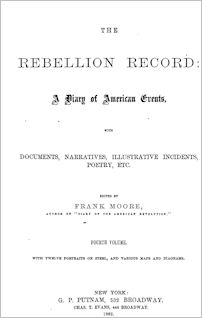April 26.—The United States steamer Flambeau, under the command of Lieut. Commanding Upshur, captured the schooner Arctic, under English colors, about seven miles below Stono, S. C—N. Y. Tribune, May 6.
—This afternoon, the pickets of colonel Donnelly’s brigade, stationed eight miles from Harrisonburgh, Va., on the Gordonsville road, were attacked by a large force of Ashby’s rear-guard, and driven back. One man, named Isaac Zelly, of the Forty-sixth Pennsylvania regiment, was killed, and three others wounded. The reserve of the Forty-sixth, and a section of Hampton’s battery then advanced and repulsed the rebels. They retreated to a wood, where several of the Union shells burst in their very midst, and a wagon was seen gathering up and carrying off their dead and wounded. — New – York Times, April 29.
—The rebel General, Albert Pike, issued a proclamation complimenting the Indian allies for their bravery at the battle at Pea Ridge, Ark. N. Y. Tribune, May 2.
—President Lincoln, at Washington, visited the French frigate Gassendi to-day—it being the first time a President of the United States ever went aboard a foreign man-of-war. He was received with the honors paid to crowned heads, the same as usually shown the Emperor. The yards were manned by the crew, who shouted; “Vive le President”
The Secretary of State and Captain Dahlgren accompanied the President. The French Minister was on board to receive the party.—National Intelligencer, April 28.
—Gen. McClellan sent the following to the War Department, at Washington:
“Early this morning an advanced lunette of the rebels, on this side of the Warwick, near its head, was carried by company H, First Massachusetts regiment. The work had a ditch six feet deep, with a strong parapet, and was manned by two companies of infantry, no artillery. Our men moved over open, soft ground, some six hundred yards, received the fire of the rebels at fifty yards, did not return it, but rushed over the ditch and parapet in the most gallant manner. The rebels broke and ran as soon as they saw that our men intended to cross the parapet. Our loss was three killed, and one mortally, and twelve otherwise wounded. We took fourteen prisoners, destroyed the work sufficiently to render it useless, and retired. The operation was conducted by Gen. C. Grover, who managed the affair most handsomely. Nothing could have been better than the conduct of all the men under fire. The supports, who were also under artillery fire of other works, were companies of the First and Eleventh Massachusetts. In spite of the rain our work progresses well.”
The following is the list of killed and wounded, all belonging to company H, First Massachusetts regiment. Killed: George P. Noyes, Wm. D. Smith, and Walter B. Andrews. Wounded: Allen A. Kingsbury, company H, mortally; George L. Stoddart George H. Campbell, Wm. H. Montague, Thos. Crittick, Horace A. Sommers, Geo. H. Stone, Wm. H. Lane, O. C. Cooper, Wm. T. Wright, James W. Spooner, William P. Hallowe, Thomas Archer.—(Doc. 150.)
—The schooner Belle was captured about thirty miles off Charleston, S. C, by the U. S. steamer Uncas.—The schooner Mersey was captured off the coast of Georgia by the U. S. steamer Santiago de Cuba.—N. Y. Tribune, May 6.
—A Battle was fought at Neosho, Mo., between one hundred and forty-six men of the First regiment of Missouri cavalry, under the command of Major Hubbard, and six hundred Indians, commanded by Cols. Coffee and Stainwright, resulting in the defeat of the latter party. Major Hubbard killed and wounded thirty of the savages, besides capturing sixty-two prisoners, seventy horses, and a large quantity of arms.—(Doc. 151.)



